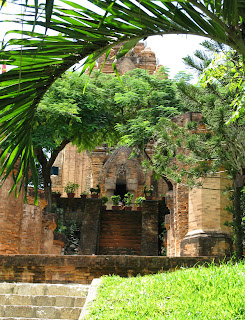Nha Trang & My Lai, 9/22-23

The morning was free in Nha Trang, so some students went to the beach, while others slept in. After a quick lunch at a Pho 24 restaurant (Vietnamese equivalent of a fast food noodle shop) we visited the Po Nagar Cham towers on the outskirts of Nha Trang. They were built between the 7th and 12th centuries.

The Champa people were an ancient civilization that controlled the central portion of what is now Vietnam until they were conquered by the Viets from the north in the 17th century. They absorbed Hinduism from Indian traders who came calling.

 To the right is a view from the tower site of the mouth of the Cai River, and Nha Trang in the background. Fishermen believe the rock in the middle of the river is good luck to them. Most Vietnamese are quite superstitious.
To the right is a view from the tower site of the mouth of the Cai River, and Nha Trang in the background. Fishermen believe the rock in the middle of the river is good luck to them. Most Vietnamese are quite superstitious.Below is Andrew explaining a Cham statue to Viet, with the main tower in the background.

On the way to Quy Nhon we took a rest stop at this beautiful beach, which is nearly deserted. There are still miles and miles of beach like this in Vietnam that haven't been discovered.



We spent a quiet evening in Quy Nhon, as there isn't much to do there. The next day we traveled to Hoi An, with a stop at My Lai, site of the massacre that gained so much attention back then. It is a moving memorial, again told from the Vietnamese government perspective, but they certainly have a right to be self-righteous in this instance. The students gained a lot by seeing it.


On that day the U.S. forces did not encounter any resistant, were not fired upon, and saw no males of fighting age, even though the area was known to be a VC stronghold. Lt. Calley's unit had only been in country about a month, and had not seen any actual combat, although it had taken several casualties as a result of booby traps and mines. The only casualty during the assault was a U.S. soldier who shot himself in the foot so he wouldn't have to participate in the killing. Why discipline completely broke down, and the massacre resulted, is still a mystery. At least we know it was an aberration, although other instances of unnecessary killing occurred in Vietnam, as they still do in Iraq.

The museum contained the diorama shown above, as well as many pictures of the area, including ones taken during and right after the massacre.

Outside there is the memorial statue to the victims, and what is claimed to be the ditch that so many bodies were found in, as well as a few survivors shielded by the dead above them.

Below Katherine is walking by a tree that still shows damage from the attack.

Mock ups of some of the houses have been reconstructed, supposedly on the original foundation sites.


Labels: 9/22-23, Nha Trang and My Lai








































